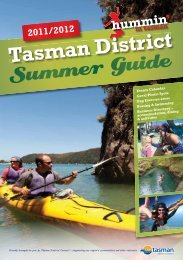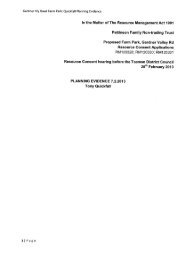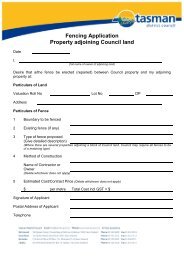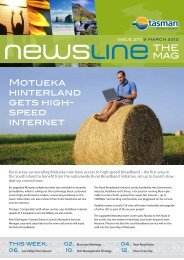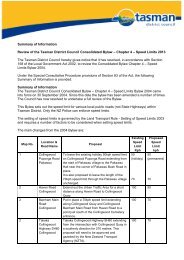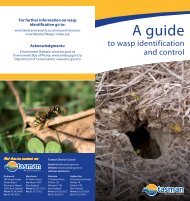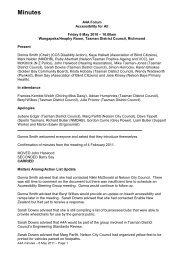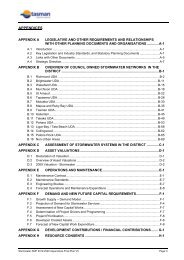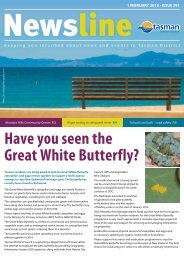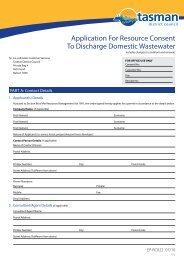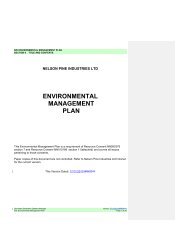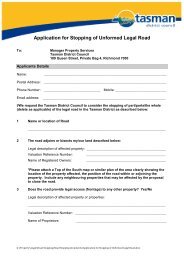Report RESC-11-03-05 NZTA Technical Audit of Local Roading ...
Report RESC-11-03-05 NZTA Technical Audit of Local Roading ...
Report RESC-11-03-05 NZTA Technical Audit of Local Roading ...
Create successful ePaper yourself
Turn your PDF publications into a flip-book with our unique Google optimized e-Paper software.
TECHNICAL REVIEW OF LOCAL ROADING<br />
in<br />
TASMAN DISTRICT COUNCIL<br />
CIL<br />
FINAL <strong>Report</strong><br />
Review Team<br />
................................................................................................................<br />
Rebecca George, <strong>Technical</strong> <strong>Audit</strong>or, NZ Transport Agency<br />
...............................................................................................................<br />
Max Aves, Manager <strong>Roading</strong> Assets, New Plymouth District Council<br />
Reviewed By<br />
.......................................................................................................<br />
Julian Chisnall, Principal Advisor Investment Monitoring, , <strong>NZTA</strong><br />
Approved By<br />
....................................................................................<br />
.............................................<br />
Marianne McMillan, Investment Monitoring Manager, <strong>NZTA</strong><br />
<strong>Report</strong> No. PM09/1497<br />
1497T APO 71-02<br />
02-02<br />
October 2010 [B1068472]
Tasman District 2010 FINAL <strong>Technical</strong> <strong>Report</strong><br />
DISCLAIMER<br />
This is a FINAL report. It has been prepared in the discharge <strong>of</strong> the NZ Transport Agency’s legal<br />
responsibility to audit the performance <strong>of</strong> approved organisations in relation to activities approved by<br />
the NZ Transport Agency.<br />
The findings, opinions and recommendations in the report are based on an examination <strong>of</strong> a sample<br />
only, and may not address all issues existing at the time <strong>of</strong> the review. So readers are urged to seek<br />
specific advice on particular matters and not rely solely on the report.<br />
While every effort has been made to ensure the accuracy <strong>of</strong> the report, it is made available strictly on<br />
the basis that anyone relying on it does so at their own risk without any liability to the NZ Transport<br />
Agency.<br />
KEY STATISTICS<br />
Total length <strong>of</strong> local roading network:<br />
1700.5 km<br />
Total length <strong>of</strong> sealed roads:<br />
927.4 km<br />
Total length <strong>of</strong> unsealed roads:<br />
773.1 km<br />
Total number <strong>of</strong> Bridges (plus length) 460 (74<strong>11</strong>.0 m)<br />
Restricted: 29, Timber: 6<br />
Total cost <strong>of</strong> District Land Transport Programme 2008/09:<br />
maintenance and renewals (NZ Transport Agency plus local<br />
$6.693 million<br />
authority):<br />
Total cost <strong>of</strong> District Land Transport Programme 2008/09:<br />
improvements (NZ Transport Agency plus local authority):<br />
$1.332 million<br />
Base financial assistance rate: 49%<br />
Population (2006 Census - Source: www.stats.govt.nz) 44,625<br />
<strong>Roading</strong> cost 2008/09 (NZ Transport Agency plus local authority) as a<br />
24%<br />
proportion <strong>of</strong> Council’s Operating Expenditure:<br />
Source: localcouncils.govt.nz<br />
Number <strong>of</strong> <strong>Local</strong> Road Crashes in 2009: Fatal 2<br />
Serious Injury 10<br />
Minor Injury 38<br />
Non Injury 107<br />
Estimated Social Cost <strong>of</strong> <strong>Local</strong> Road Crashes on Tasman District<br />
$20.40 million<br />
Council’s network in 2009 (from CAS):<br />
ii
Tasman District 2010 FINAL <strong>Technical</strong> <strong>Report</strong><br />
Contents<br />
1 EXECUTIVE SUMMARY ................................................................................................... 1<br />
1.1 Review Dates ........................................................................................................ 1<br />
1.2 Scope <strong>of</strong> Review .................................................................................................... 1<br />
1.3 Review Conclusions ............................................................................................... 1<br />
2 RECOMMENDATIONS .................................................................................................... 2<br />
2.1 Recommendations ................................................................................................. 2<br />
2.2 Suggestions ......................................................................................................... 2<br />
3 REVIEW FINDINGS ........................................................................................................ 3<br />
3.1 Review Objectives and Principal Findings ................................................................... 3<br />
3.1.1 Objective 1: Progress since last review............................................................... 3<br />
3.1.2 Objective 2: Level & Quality ............................................................................. 3<br />
3.1.3 Objective 3: Meeting Needs ............................................................................. 3<br />
3.1.4 Objective 4: Reliability <strong>of</strong> Road Assessment & Maintenance Management Database ... 4<br />
3.1.5 Objective 5: Progress towards long-term programme ........................................... 4<br />
3.2 Previous Reviews ................................................................................................... 5<br />
3.3 Management Systems............................................................................................. 6<br />
3.3.1 Policy and Planning ........................................................................................ 6<br />
3.3.2 Resourcing ................................................................................................... 7<br />
3.3.3 Monitoring.................................................................................................... 8<br />
3.4 Pavement Management Systems............................................................................... 9<br />
3.4.1 RAMM Database............................................................................................. 9<br />
3.4.2 Treatment selection.......................................................................................10<br />
3.4.3 Traffic Count Data.........................................................................................<strong>11</strong><br />
3.5 Pavement Maintenance ..........................................................................................12<br />
3.5.1 Sealed Network Condition Trends ....................................................................12<br />
3.5.2 Pavement Maintenance Programme ..................................................................16<br />
3.5.3 Unsealed Road Maintenance............................................................................19<br />
3.6 Environmental Maintenance & Safety Issues...............................................................20<br />
3.6.1 Bridges & Structures ......................................................................................20<br />
3.6.2 Road Corridor & Traffic Services ......................................................................22<br />
3.6.3 Minor Improvements .....................................................................................23<br />
3.6.4 Safety Management .......................................................................................23<br />
3.7 Subdivision Management and Land Use ....................................................................26<br />
4 METHODOLOGY .........................................................................................................27<br />
4.1 Scope <strong>of</strong> Review ...................................................................................................27<br />
4.2 Authority to Review (NZ Transport Agency Requirement to <strong>Audit</strong>)..................................27<br />
4.3 Review Team .......................................................................................................27<br />
4.4 Fieldwork............................................................................................................27<br />
4.5 Consultation on the Draft <strong>Report</strong>.............................................................................27<br />
5 ACKNOWLEDGEMENTS .................................................................................................28<br />
Appendix A - <strong>Audit</strong> Plan 2009/10: <strong>Technical</strong> Review <strong>of</strong> Tasman District Council<br />
Appendix B - Comments on the Draft <strong>Report</strong> from Tasman District Council<br />
Appendix C – Comparative Expenditure Charts<br />
iii
Tasman District 2010 FINAL <strong>Technical</strong> <strong>Report</strong><br />
This page is intentionally blank<br />
iv
1 EXECUTIVE SUMMARY<br />
1.1 Review Dates<br />
The road maintenance programme for Tasman District Council was reviewed between 19 and 22 July<br />
2010. This review was conducted as part <strong>of</strong> Performance Monitoring Unit’s business plan for<br />
2009/2010 financial year.<br />
1.2 Scope <strong>of</strong> Review<br />
• To review progress since the last technical review.<br />
• To assess whether the level and quality <strong>of</strong> road maintenance being carried out by Tasman<br />
District Council is realistic and acceptable.<br />
• To determine the extent to which Tasman District Council’s structural and corridor maintenance<br />
programme is meeting (not exceeding) maintenance needs.<br />
• To determine the extent to which Council’s road assessment & maintenance management<br />
database is able to provide reliable reports and treatment selections.<br />
• To determine whether in light <strong>of</strong> answers to the above questions there is progress towards<br />
achieving a balanced whole <strong>of</strong> life maintenance programme.<br />
1.3 Review Conclusions<br />
The audit team were <strong>of</strong> the view that Tasman is in the sort <strong>of</strong> condition that could be expected <strong>of</strong> a well<br />
managed network. Council clearly understands the importance for their network <strong>of</strong> being proactive<br />
and they are well-placed to effectively deliver an appropriate Level <strong>of</strong> Service to the community.<br />
The Tasman network has a large unsealed portion that is particularly susceptible to horticulture and<br />
forestry impacts and there was good recognition by Council <strong>of</strong> these pressure factors on its network.<br />
The network and its pavements are well understood, with the one weakness being major drainage.<br />
Improvement <strong>of</strong> drainage will require an increased focus on maintenance items such as high shoulders<br />
and gradual creation and reinstatement <strong>of</strong> water tables, on both the sealed and the unsealed rural<br />
networks.<br />
The standard <strong>of</strong> services delivered is consistent across the four contract areas and across both<br />
maintenance contractors. Pr<strong>of</strong>essional services are well supported and prioritised by the long standing<br />
local consultant.<br />
There has been good progress with the RAMM database and our findings should be easily addressed.<br />
Good ownership with smart buyer capability is apparent within both Council and their consultant. As<br />
the new team continue to establish, we expect the balance <strong>of</strong> ownership to re-orient more towards<br />
Council. The new transport team is well placed to deliver a balanced whole <strong>of</strong> life maintenance<br />
programme.<br />
1
Tasman District 2010 FINAL <strong>Technical</strong> <strong>Report</strong><br />
2 RECOMMENDATIONS<br />
The following is a summary <strong>of</strong> our recommendations and suggestions. In some cases, this section <strong>of</strong><br />
the report may carry an abbreviation <strong>of</strong> the full wording. The appropriate section <strong>of</strong> the report should<br />
always be referred to for the full statement in its context.<br />
2.1 Recommendations<br />
We recommend that Council:<br />
a) Reviews treatment lengths, to ensure reliable treatment selection analysis can be undertaken<br />
(refer section 3.4.1);<br />
b) Develop and implement a programme to improve rural road network drainage standards (refer<br />
section 3.5.2.); and<br />
c) Continues to adopt and act on the findings <strong>of</strong> the 2009 RISA review (refer section 3.6.4).<br />
2.2 Suggestions<br />
We suggest that Council:<br />
a) Implement the recommendations <strong>of</strong> their consultant’s 2009 RAMM Annual <strong>Audit</strong> <strong>Report</strong>,<br />
including consideration <strong>of</strong> these <strong>Technical</strong> <strong>Audit</strong> comments (refer section 3.4.1); and<br />
b) Introduce consistent on site bridge naming and identification (refer section 3.6.1).<br />
2
Tasman District 2010 FINAL <strong>Technical</strong> <strong>Report</strong><br />
3 REVIEW FINDINGS<br />
3.1 Review Objectives and Principal Findings<br />
F<br />
3.1.1 Objective 1: Progress since last review<br />
To review progress since the last review.<br />
The findings <strong>of</strong> the previous <strong>Technical</strong> <strong>Audit</strong> are now <strong>of</strong> historic interest only. Interim reviews looking<br />
at RAMM database condition (1998) and Asset Management Planning (2007) have found the Tasman<br />
network and its management structure well progressed, but with opportunities for improvement<br />
remaining. Some <strong>of</strong> these have been discussed and noted as part <strong>of</strong> this current review.<br />
3.1.2 Objective 2: Level & Quality<br />
To assess whether the level and quality <strong>of</strong> roading maintenance being carried out by Tasman District<br />
Council is realistic and acceptable.<br />
The current level and quality <strong>of</strong> roading maintenance activity being carried out by Tasman District<br />
Council is realistic and acceptable with the exception <strong>of</strong> rural roadside drainage, which requires a<br />
sustained and systematic approach to effect network wide improvement (refer section 3.5.2).<br />
3.1.3 Objective 3: Meeting Needs<br />
To determine the extent to which Tasman District Council’s structural and corridor maintenance<br />
programme is meeting (not exceeding) maintenance needs.<br />
Council’s current structural and corridor maintenance programme is well matched to the needs <strong>of</strong> the<br />
network. Where there are weaknesses they have been identified by the new asset management team<br />
and correction processes have commenced.<br />
Council’s staff is well able to manage network needs and their ability to identify and deliver the<br />
structural and corridor maintenance programme will only improve with network familiarity.<br />
3
Tasman District 2010 FINAL <strong>Technical</strong> <strong>Report</strong><br />
3.1.4 Objective 4: Reliability <strong>of</strong> Road Assessment & Maintenance Management Database<br />
To determine the extent to which Council’s road assessment and maintenance management database<br />
is able to provide reliable reports and treatment selections.<br />
Council’s RAMM database is well managed by the consultant. There remain areas in need <strong>of</strong><br />
improvement, but these are prioritised by the consultant for Council with clear explanations. We<br />
expect Council to progress these.<br />
Good progress has been made with the database and it can be considered more reliable than most.<br />
Treatment lengths are discussed in detail (refer section 3.4) and we recommend they be reviewed.<br />
3.1.5 Objective 5: Progress towards long-term programme<br />
To determine whether in light <strong>of</strong> answers to the above questions there is progress towards achieving a<br />
balanced, whole <strong>of</strong> life maintenance programme.<br />
Members <strong>of</strong> the new asset management team are actively engaged in familiarising themselves with the<br />
Tasman network. They are stepping up as network owners, both questioning and critiquing the advice<br />
and recommendations given. We expect that if this level <strong>of</strong> ownership is sustained and broadened to<br />
the internal elements affecting the network, then Council will be well on its way to achieving a balanced<br />
whole <strong>of</strong> life maintenance programme that will deliver value for investment to both <strong>NZTA</strong> and the local<br />
Tasman community.<br />
4
Tasman District 2010 FINAL <strong>Technical</strong> <strong>Report</strong><br />
3.2 Previous Reviews<br />
The last <strong>Technical</strong> Review, by <strong>NZTA</strong> or its predecessor organisations, was in April 1998 – this is<br />
considered to be <strong>of</strong> historical interest only, due to the passing <strong>of</strong> time, legislative changes, and staff<br />
changes.<br />
The 1998 review included consideration <strong>of</strong> the RAMM database. It noted minor data discrepancies<br />
requiring attention and recommended review <strong>of</strong> the surface life tables, but otherwise concluded that<br />
the integrity <strong>of</strong> the database was satisfactory. The RAMM database is discussed later in section 3.4 <strong>of</strong><br />
this review.<br />
In September 2007, <strong>NZTA</strong> commissioned a desktop review to assess the standard <strong>of</strong> Asset<br />
Management Plans (AMP) across New Zealand. The 2006 Tasman District Council <strong>Roading</strong> Activity<br />
Management Plan (RAMP) was assessed as being at an overall “Basic to Intermediate” stage with the<br />
Financial Information element described as Excellent. Key areas <strong>of</strong> weakness were identified as Risk<br />
Management, Assets and Data, and Process <strong>of</strong> Development.<br />
Council’s current AMP, Transportation Activity Management Plan (TAMP), is dated 2009 and identifies<br />
the improvements since the 2006 version was reviewed and outlines an improvement programme.<br />
Although the TAMP notes that “Council does not have a Risk Management Plan”, it does clearly outline<br />
the “Integrated Risk Management” framework and process currently under adoption.<br />
5
Tasman District 2010 FINAL <strong>Technical</strong> <strong>Report</strong><br />
3.3 Management Systems<br />
3.3.1 Policy and Planning<br />
An Activity Management Plan (AMP) gives effect to <strong>Local</strong> and Central Government high level strategies,<br />
through detailing specific plans and programmes for management <strong>of</strong> the asset and delivery <strong>of</strong> the<br />
service. By using reliable asset information <strong>Local</strong> Authorities will be able to identify and deliver critical<br />
services to communities more effectively and efficiently.<br />
Council has made good progress with development <strong>of</strong> it’s TAMP and the latest version shows clear<br />
linkages between Community Outcomes and the adopted Levels <strong>of</strong> Service.<br />
Council understands the role <strong>of</strong> policy and strategy development and has:<br />
• developed a Maintenance Intervention Strategy;<br />
• regularly reviews its Forest Impact Strategy;<br />
• reviewed its <strong>Roading</strong> Policy Manual;<br />
• is currently reviewing its Engineering Standards; and<br />
• is considering how best to respond to irrigation and other private assets informally crossing<br />
the road corridor.<br />
The matter <strong>of</strong> sustainability <strong>of</strong> some <strong>of</strong> Council’s very low trafficked routes was recognised in<br />
discussion and is identified in the 2009 TAMP, but in Council’s view does not yet warrant development<br />
<strong>of</strong> a formal policy.<br />
Council is co-operating with <strong>NZTA</strong> and industry to develop routes suitable for High Productivity<br />
vehicles (as permitted under the Vehicle Dimensions and Mass Amendment 2010). In discussion with<br />
industry, routes have been identified. A particular risk for Tasman is the susceptibility <strong>of</strong> its pavement<br />
layers to deterioration and their extreme sensitivity to minor changes in traffic composition and<br />
moisture content.<br />
Awareness <strong>of</strong> these risks and the economic impact for the entire region drive Council in its wish to<br />
proactively manage its pavements. The challenge with this pro-active approach, particularly in the<br />
current funding regime, is to build an evidence base that is robust and able to stand the test <strong>of</strong><br />
scrutiny. To effectively support a proposal that may otherwise seem premature, Council will need to<br />
collect experience and evidence <strong>of</strong> behaviour beyond the proposed sites and from across the network.<br />
The <strong>NZTA</strong> expects that all approved organisations will have an endorsed procurement strategy and be<br />
using the Procurement Manual by 1 October 2010. From this date, the Competitive Pricing Procedures<br />
will be withdrawn and will no longer be valid for procuring activities funded through the NLTP. It is<br />
considered best practice that procurement strategies cover at least a three-year NLTP work<br />
programme. Tasman DC had commenced development <strong>of</strong> its Procurement Strategy and the document<br />
has since been endorsed by <strong>NZTA</strong> and approved by Council.<br />
Development <strong>of</strong> Council’s procurement strategy will create another opportunity to look at how Council<br />
manages the asset. Its preparation will demonstrate that Council knows and understands the needs <strong>of</strong><br />
the network and its services and has given consideration to how this can and should be delivered.<br />
6
Tasman District 2010 FINAL <strong>Technical</strong> <strong>Report</strong><br />
This audit team were <strong>of</strong> the opinion that Tasman DC is well placed to achieve a balanced whole <strong>of</strong> life<br />
maintenance programme.<br />
3.3.2 Resourcing<br />
A level <strong>of</strong> independence is required to enable Council to critically assess and determine the future<br />
direction <strong>of</strong> the road asset and meet its obligations under the Land Transport Management Act (LTMA).<br />
Council needs to satisfy itself that they have sufficient resources to plan, programme, supervise and<br />
monitor the network and its maintenance, whether this is as a direct report or through its pr<strong>of</strong>essional<br />
services consultant.<br />
Council is encouraged to have a “smart buyer” approach to selection <strong>of</strong> services (both pr<strong>of</strong>essional and<br />
physical). Such an approach requires Council to:<br />
• Assess competition for the work being tendered;<br />
• Define the outcomes sought on Council’s behalf;<br />
• Define the performance required <strong>of</strong> suppliers; and<br />
• Critically assess and monitor the outputs it receives.<br />
The Transport team is a relatively new team to the Tasman network and is in the process <strong>of</strong><br />
transitioning the balance <strong>of</strong> responsibility from the consultant (and elsewhere in Council) back into<br />
their team. We were confident that the team has sufficient technical knowledge to act as a “smart<br />
buyer” and confidently critique the advice it receives.<br />
The contracts <strong>of</strong>ficer at Council submits funding applications, but there remained a question as to who<br />
at council has delegation to apply for funds and who prioritises funding allocations. We noted the<br />
need for improved clarity over where delegations sit within Council – particularly where there is asset<br />
overlap (such as with development and with water courses) and as some decision making is<br />
transitioned back to Council from its consultant.<br />
Council has benefitted from continuity <strong>of</strong> service in their pr<strong>of</strong>essional services consultant. There is<br />
clearly a high level <strong>of</strong> familiarity with the network and high levels <strong>of</strong> ownership. The risk <strong>of</strong> such an<br />
arrangement is exposure to loss <strong>of</strong> institutional knowledge and intellectual property in the event <strong>of</strong><br />
eventual change. Council has acknowledged the risk <strong>of</strong> so much knowledge sitting outside <strong>of</strong> its<br />
purview and is acting to minimise the risk. Appropriate processes should be put in place to protect<br />
systems and processes developed for the ongoing management <strong>of</strong> the asset, including a transition<br />
process.<br />
The consultant is the engineer to the contract and has direct delegation for management <strong>of</strong> the<br />
contractors, but the new asset team has encouraged greater discretion for the contractors, with the<br />
pr<strong>of</strong>essional services consultant backing away from the detailed planning <strong>of</strong> the work programme. We<br />
believe that it is appropriate for the contractor to have greater discretion over the delivery <strong>of</strong> the work<br />
programme.<br />
Maintenance <strong>of</strong> the Tasman network is broadly structured into four geographical areas and separate<br />
bridges/structures contracts. We encourage Council to regularly review this arrangement to ensure<br />
that it continues to provide optimal value for Council and the community.<br />
7
Tasman District 2010 FINAL <strong>Technical</strong> <strong>Report</strong><br />
We were satisfied that Council has adequate knowledge and resources to efficiently manage the<br />
Tasman Road network and assets.<br />
3.3.3 Monitoring<br />
Council has a geographically dispersed, predominantly rural network. To understand it and respond<br />
appropriately, Council needs a sound and robust monitoring process, collating relevant information<br />
and appropriately applying it to the ongoing maintenance and development <strong>of</strong> the asset.<br />
Network videoing was discussed as a useful tool that can provide a snapshot, at a point in time, <strong>of</strong> the<br />
network shoulders and surfaces. With consideration, such footage can be usefully applied to improved<br />
management <strong>of</strong> the maintenance contract, improved customer service and the broader management <strong>of</strong><br />
the asset.<br />
Council collects a wide range <strong>of</strong> traffic count information using an independent contractor. We noted<br />
the use <strong>of</strong> single tube counters on rural routes and discussed the merits for Council, with<br />
improvements in technology, <strong>of</strong> also collecting axle (Heavy vehicle) and speed information.<br />
Modern technology, particularly improvements in data capture, manipulation and presentation, creates<br />
opportunities for improved asset management. Council has made good use <strong>of</strong> its geospatial<br />
information. We encourage Council to continue to develop and effectively exploit this technology for<br />
understanding <strong>of</strong> the road asset and adjoining land uses. Large dispersed networks are finding<br />
benefits from aerial photography and corridor video in both their day to day operations and longer<br />
term planning.<br />
The challenge for Council, in monitoring the network, is to balance the quantity and frequency <strong>of</strong> data<br />
collection/observations to provide best value and optimal efficiency.<br />
8
Tasman District 2010 FINAL <strong>Technical</strong> <strong>Report</strong><br />
3.4 Pavement Management Systems<br />
3.4.1 RAMM Database<br />
Council operates a RAMM 2008 database and uses this for its pavement, footpath and bridge asset<br />
information. Retaining wall information has yet to be captured (but this is identified as a desired<br />
improvement in the AMP and is underway) and streetlight information is stored in an alternative<br />
database (Confirm).<br />
The RAMM database is managed and maintained by an external consultant with full reporting back to<br />
Council. A 2009 “RAMM Annual <strong>Audit</strong> <strong>Report</strong>” to Council, from its consultant, indicated the state <strong>of</strong> the<br />
database as generally well maintained and suggested prioritised improvements to some aspects <strong>of</strong> the<br />
information in order to add value to the database.<br />
Previous <strong>NZTA</strong> reviews and currently available audit queries support the finding that the Tasman<br />
database is well maintained. The relevant fields are populated and the database is generally able to<br />
provide accurate and reliable reports.<br />
There are a number <strong>of</strong> long treatment lengths, beyond 2km and 5km long. Excessively short or long<br />
treatment lengths should, where practical, be avoided. They can reduce the reliability <strong>of</strong> treatment<br />
selection and the value <strong>of</strong> roughness rating information, to the point that it is negligible and the data<br />
collection investment is virtually wasted. We recommend this situation be addressed.<br />
Council needs to review its longer treatment lengths and split them into more manageable lengths.<br />
Lengths less than 2km can more accurately represent the length sealed each season and any age<br />
related deterioration (as noted through condition and roughness rating).<br />
Council’s Annual Achievement return (based on RAMM) indicates that the sealed network length<br />
overdue for resurfacing is about 14% <strong>of</strong> the total sealed network and that Council currently resurfaces<br />
about 8%. The highest proportion <strong>of</strong> “overdue” surfacings is in the Rural C (27%) and Urban C (29%)<br />
Treatment Lengths - these represent the 1000-5000 vehicles per day roads, but currently appear to be<br />
included in Council’s forward programme considerations. The total quantity <strong>of</strong> “overdue” resurfacing is<br />
greater than the annual resurfacing programme, but well able to be managed within Council’s current<br />
programme.<br />
Default surface lives have previously been an area requiring increased emphasis and understanding by<br />
councils. Accurate surface lives will increase the quality and accuracy <strong>of</strong> treatment selection reporting<br />
– particularly where there maybe a greater life remaining than that indicated by industry established<br />
defaults. We encourage Council to regularly review and update the surface lives to ensure that they<br />
appropriately reflect the local conditions <strong>of</strong> their network.<br />
Areas for particular attention and ongoing consideration include Treatment Lengths (TL), surface lives<br />
and the capture <strong>of</strong> remaining structures.<br />
Recommendation:<br />
That Council reviews treatment lengths, to ensure reliable treatment selection analysis can be<br />
undertaken.<br />
9
Tasman District 2010 FINAL <strong>Technical</strong> <strong>Report</strong><br />
Suggestion:<br />
That Council implement<br />
i<br />
the recommendations <strong>of</strong> their consultant’s 2009 RAMM Annual <strong>Audit</strong><br />
<strong>Report</strong>, including consideration <strong>of</strong> these <strong>Technical</strong> <strong>Audit</strong> A<br />
comments.<br />
3.4.2 Treatment Selection<br />
Council should be able to demonstrate how the road maintenance, renewal and capital works minimise<br />
the life-cycle costs <strong>of</strong> their network assets – i.e. how they are providing best value for the community’s<br />
investment.<br />
<strong>NZTA</strong> looks for evidence based submissions and performance prediction modelling is one <strong>of</strong> the tools<br />
that can help. Council should ensure they maintain a high level <strong>of</strong> core data integrity (asset inventory,<br />
condition, cost and traffic data). The <strong>NZTA</strong>’s Planning, Programming and Funding Manual (PPFM) is<br />
very clear on this point “Only once confidence in these elements is complete should organisations<br />
consider moving onto advanced predictive methods <strong>of</strong> long term planning.” (Chapter F2 Transport<br />
Planning, F2.4, pages F2-17).<br />
The Treatment Selection Algorithm (TSA) is a key tool for assessment and national comparison <strong>of</strong><br />
Approved Organisations and their <strong>Roading</strong> Programmes. Regardless <strong>of</strong> other advanced programme<br />
development techniques used by authorities (such as dTIMS) <strong>NZTA</strong> requires submission <strong>of</strong> a TSA<br />
assessment in support <strong>of</strong> the proposed maintenance programme (PPFM, Chapter 7.4 Supporting<br />
information for road operations, maintenance and renewal programmes, Page C7-5).<br />
Despite Tasman having run TSA in 2008, this information was not submitted in LTP Online (LTPO). If<br />
Council is concerned about gaining access to full funding then we encourage it to maximise all<br />
opportunities by providing robust supporting information, particularly those required by funding rules.<br />
We note that the Pavement Performance information attached in LTPO was dated November 2006 and<br />
reports on the third year <strong>of</strong> dTIMS modelling on the Tasman network. Again this was supported with<br />
detailed reporting to Council outlining areas where they can add value to its database and model<br />
outputs.<br />
Models with an increased level <strong>of</strong> sophistication (such as dTIMS) require a higher level <strong>of</strong> data integrity<br />
and ongoing maintenance <strong>of</strong> that information. The dTIMS technical report noted the reliance <strong>of</strong> the<br />
predictive modelling on accuracy <strong>of</strong> the network inventory. It noted inaccuracies <strong>of</strong> pavement and<br />
surface dates and reiterated the importance <strong>of</strong> Traffic Count and Loading Data to the dTIMS process.<br />
The database has been developed further since this model was run. Much <strong>of</strong> the pavement and surface<br />
information has been improved and continues to be considered. There remains the opportunity to<br />
improve the quality <strong>of</strong> pavement loading information – collecting heavy vehicle or axle count<br />
information.<br />
Regardless <strong>of</strong> the treatment selection tool, Council needs to be confident that the stored data is<br />
relevant, reliable and provides a suitable foundation for decision making and forecasting. Council has<br />
made good improvements to its RAMM database. This progress needs to continue, with the database<br />
10
Tasman District 2010 FINAL <strong>Technical</strong> <strong>Report</strong><br />
being customised (with appropriate quality control) to the local conditions and this local knowledge<br />
then applied to improve the understanding <strong>of</strong> the network and its specific needs.<br />
We were satisfied that Council’s current programme development is adequate for Council’s purposes –<br />
both in identifying works and managing/balancing expenditure. Council’s Road Asset & Maintenance<br />
Management (RAMM) database is able to provide reliable reports and treatment selections.<br />
3.4.3 Traffic Count Data<br />
<strong>NZTA</strong> expects that Council will maintain their core asset information so that it is sufficiently complete<br />
for its expected use. There needs to be consideration <strong>of</strong> appropriate and ongoing<br />
renewal/replacement <strong>of</strong> the collected data, in particular information about traffic use and distribution.<br />
We encourage Council to populate the heavy vehicle (HCV) data fields in RAMM with actual vehicle<br />
classifications, or at least collect sufficient data to demonstrate a reasonable level <strong>of</strong> confidence in the<br />
default values used. dTIMS models (in particular) are more sensitive to the proportion <strong>of</strong> heavy<br />
vehicles and require the use <strong>of</strong> actual vehicle classifications.<br />
Council needs to ensure that its traffic counting programme is adequately capturing (both quality and<br />
quantity) the seasonal and annual variation on its network as well as the extremes arising from erratic<br />
loading (such as occurs with forestry operations, dairying or other changes in land use). We encourage<br />
Council to clarify the rationale for traffic data collection and formalise its data collection programme.<br />
To assist local authorities, the <strong>NZTA</strong> has recently developed a traffic counting module “Traffic Count<br />
Estimation” (included in RAMM 2008 and later versions). The module can recommend traffic count<br />
sites, improve estimates by incorporating annualisation and seasonal factors, extrapolate counts<br />
across the link and calculate traffic growth rates.<br />
<strong>11</strong>
Tasman District 2010 FINAL <strong>Technical</strong> <strong>Report</strong><br />
3.5 Pavement Maintenance<br />
3.5.1 Sealed Network Condition Trends<br />
The <strong>NZTA</strong>’s PPFM (pF7-13, section F7.9, July 2009) requires annual roughness and condition rating, <strong>of</strong><br />
“all sealed roads carrying more than 500 vehicles per day”, with lesser trafficked roads rated at least<br />
every two years. Low volume routes with high proportions <strong>of</strong> heavy traffic should also be surveyed<br />
annually. This philosophy generally allows the identification <strong>of</strong> “at risk” routes (those carrying either<br />
heavy or high volumes) earlier in the deterioration cycle.<br />
There are fewer than 500 vehicles per day (vpd) on 81% <strong>of</strong> the Tasman network (and less than 100 vpd<br />
on 46%). Council regularly carries out both condition and roughness rating (high speed data) - Partial<br />
network rating is alternated with full network rating. The rating frequency is appropriate and results<br />
indicate reasonable consistency between successive surveys. However we note the need for attention<br />
to quality control and encourage Council to consider the change in 2008/9 results and how they relate<br />
to 2010 surveys (when they are available).<br />
As part <strong>of</strong> the <strong>NZTA</strong>’s monitoring <strong>of</strong> the implementation <strong>of</strong> approved activities and to meet its statutory<br />
responsibilities, the <strong>NZTA</strong> requires various reports from approved organisations. One <strong>of</strong> these is<br />
Annual Achievement <strong>Report</strong>ing (due 31 July, annually), which requires a summary <strong>of</strong> Council’s most<br />
recent pavement rating information. The following range <strong>of</strong> graphs and tables demonstrate network<br />
trends derived from annual returns to <strong>NZTA</strong> by Tasman District Council for the 2008/9 year.<br />
The STE, CI and PII indicators are derived from the input data shown below in Table 1.<br />
Table 1: Input Data to Pavement Indicators<br />
Indicator<br />
Smooth Travel Exposure (STE)<br />
(Note - no weighting <strong>of</strong> data.)<br />
Condition Index (CI)<br />
Pavement Integrity Index (PII)<br />
Input Data<br />
Percentage <strong>of</strong> travel undertaken on sealed roads with<br />
roughness less than 5.71 IRI (150 NAASRA counts/km).<br />
%age <strong>of</strong> alligator cracking<br />
%age area <strong>of</strong> scabbing<br />
%age area <strong>of</strong> potholes<br />
%age area <strong>of</strong> pothole patches<br />
%age area <strong>of</strong> flushing<br />
As for Condition Index (CI), plus<br />
%age <strong>of</strong> Rutting<br />
Average roughness<br />
%age <strong>of</strong> Shoving<br />
Smooth Travel Exposure (STE) for the Tasman network shows a steady trend with a marked<br />
improvement in the urban performance in the most recent survey (2008/09). Data quality should be<br />
confirmed and these results compared to the 2009/10 rating information as it becomes available.<br />
Overall, and as shown in Graph 1, the STE indicator appears to be tracking slightly better than the<br />
national average.<br />
12
Tasman District 2010 FINAL <strong>Technical</strong> <strong>Report</strong><br />
Graph 1 Smooth travel exposure for all sealed roads<br />
100%<br />
90%<br />
80%<br />
Smooth travel exposure (STE) %<br />
70%<br />
60%<br />
50%<br />
40%<br />
30%<br />
20%<br />
10%<br />
0%<br />
2004/20<strong>05</strong> 20<strong>05</strong>/2006 2006/2007 2007/2008 2008/2009<br />
Tasman District - urban Tasman District - rural Tasman District - network<br />
New Zealand - urban New Zealand - rural New Zealand - network<br />
Graph 2: Surface Condition for all sealed roads<br />
100<br />
99<br />
Condition Index (100 - CI)<br />
98<br />
97<br />
96<br />
95<br />
94<br />
2004/20<strong>05</strong> 20<strong>05</strong>/2006 2006/2007 2007/2008 2008/2009<br />
Tasman District - urban Tasman District - rural Tasman District - network<br />
New Zealand - urban New Zealand - rural New Zealand - network<br />
The Condition Index (CI), Graph 2, remains above the NZ averaged value, but has shown a steady<br />
decline, indicating an increase in surface faults with urban and rural results diverging at the last<br />
survey. In the urban area it was evident that crack sealing had been applied to road openings and<br />
general pavement repairs – a timely intervention that can extend the life <strong>of</strong> a surfacing. This result<br />
indicates a decline <strong>of</strong> the rural surfaces and is a probable pre-cursor to wider deterioration <strong>of</strong> the rural<br />
network.<br />
13
Tasman District 2010 FINAL <strong>Technical</strong> <strong>Report</strong><br />
Graph 3: Pavement Integrity for all sealed roads<br />
100<br />
98<br />
Pavement integrity index (100 - PII)<br />
96<br />
94<br />
92<br />
90<br />
88<br />
86<br />
2004/20<strong>05</strong> 20<strong>05</strong>/2006 2006/2007 2007/2008 2008/2009<br />
Tasman District - urban Tasman District - rural Tasman District - network<br />
New Zealand - urban New Zealand - rural New Zealand - network<br />
The Pavement Integrity Index, graph 3, indicates the condition <strong>of</strong> the deeper pavement layers. The<br />
reported data indicates that the both the urban and rural integrity are beginning to deteriorate. This<br />
shows the vulnerability <strong>of</strong> lower pavements and the need for prudent top surface maintenance to<br />
maintain Level <strong>of</strong> Service standards and avoid unnecessary expensive structural repairs.<br />
Graph 4: Vehicle kilometres travelled on local roads<br />
250<br />
1.20%<br />
vehicle kilometres travelled (VKT) (million km)<br />
200<br />
150<br />
100<br />
50<br />
1.00%<br />
0.80%<br />
0.60%<br />
0.40%<br />
0.20%<br />
% <strong>of</strong> total<br />
0<br />
2004/20<strong>05</strong> 20<strong>05</strong>/2006 2006/2007 2007/2008 2008/2009<br />
0.00%<br />
Tasman District (local roads)<br />
Tasman District as % <strong>of</strong> NZ (local roads)<br />
14
Tasman District 2010 FINAL <strong>Technical</strong> <strong>Report</strong><br />
The Vehicle Kilometres Travelled (VKT) shown in Graph 4 is derived from count data recorded in RAMM<br />
and as reported by Council in its annual achievement returns. It shows negligible change in the total<br />
network travel.<br />
These VKT values are aggregated to produce national values <strong>of</strong> network use and traffic growth. The<br />
accuracy <strong>of</strong> VKT is dependent upon the quality (and quantity) <strong>of</strong> the traffic counting programme and<br />
the quality <strong>of</strong> the individual counts collected.<br />
Pavement roughness trends are shown in Graph 5. <strong>NZTA</strong> considers and compares the extremes <strong>of</strong><br />
road roughness, i.e. >5.71 IRI (150 NAASRA). Other authorities may also choose to monitor the<br />
roughness <strong>of</strong> their network by trending such results as the average roughness (either NAASRA or IRI) or<br />
other values as appropriate to their community stated objectives.<br />
The proportion <strong>of</strong> Council’s sealed roads exhibiting a roughness count <strong>of</strong> greater than 5.71 IRI<br />
(150 NAASRA) has fluctuated over the last 5 years. It is worth noting the importance <strong>of</strong> appropriate<br />
treatment length selection as this data represents a single roughness figure per treatment section.<br />
Overall, the Tasman District Council network has a lower proportion <strong>of</strong> “rough” roads in comparison<br />
with all New Zealand authorities.<br />
Graph 5: Road Roughness<br />
12.0%<br />
Road roughness for Tasman District<br />
% lane km > 5.71 IRI (150 NAASRA) counts<br />
10.0%<br />
8.0%<br />
6.0%<br />
4.0%<br />
2.0%<br />
0.0%<br />
20<strong>03</strong>/2004 2004/20<strong>05</strong> 20<strong>05</strong>/2006 2006/2007 2007/2008 2008/2009<br />
Tasman District<br />
All New Zealand<br />
15
Tasman District 2010 FINAL <strong>Technical</strong> <strong>Report</strong><br />
3.5.2 Pavement Maintenance Programme<br />
Historically, Council’s structural maintenance programme has been resurfacing an average <strong>of</strong> 75 km<br />
per annum, which is very close to the 8% <strong>of</strong> sealed network per annum indicated as New Zealand good<br />
practice and consistent with the recommendations <strong>of</strong> Council’s long term database analysis.<br />
The length <strong>of</strong> overdue resurfacing reported by the database is dependent on the default life values<br />
used and the life expired percentage chosen in the TSA decision factors. The Tasman RAMM data<br />
indicates that 14% <strong>of</strong> the network is overdue for resurfacing. This is more than Council’s programmed<br />
reseal length, but as discussed in the RAMM data is manageable within the current 10 year programme.<br />
Graph 6: Sealed network condition vs. indexed network structural maintenance *<br />
$14.0<br />
100<br />
$12.0<br />
98<br />
$10.0<br />
96<br />
maintenance costs<br />
$8.0<br />
$6.0<br />
$4.0<br />
94<br />
92<br />
90<br />
index<br />
$2.0<br />
88<br />
$0.0<br />
86<br />
2004/20<strong>05</strong> 20<strong>05</strong>/2006 2006/2007 2007/2008 2008/2009<br />
Tasman District maintenance (excl. emergency work)<br />
Tasman District maintenance - indexed<br />
Tasman District smoothness % (STE)<br />
Tasman District pavement integrity % (100 - PII)<br />
Tasman District surface Condition % (100 - CI)<br />
* For programmes funded through <strong>NZTA</strong> only<br />
The above, Graph 6, indicates that the current level <strong>of</strong> investment is maintaining the network<br />
condition. This is consistent with the observed network condition and is an indication <strong>of</strong> good asset<br />
management, which will be reinforced by improvement <strong>of</strong> major drainage. Council needs to ensure<br />
that this level <strong>of</strong> investment is maintained in future maintenance programmes to ensure no long term<br />
decline in condition <strong>of</strong> the asset.<br />
Graph 7 below is based upon information from Council’s previous final claims for financial assistance,<br />
from LTP Online. Changes in work categories (by <strong>NZTA</strong> in 2008) limit the level <strong>of</strong> comparison practical<br />
until a new history is established. The graph suggests that Council’s maintenance costs are rising in<br />
line with the regional/national trend and that there is currently a greater spend on pavement renewals<br />
than maintenance. When considered in conjunction with the other reviewed data, this suggests that<br />
Council’s maintenance programme is appropriate for the current need.<br />
16
Tasman District 2010 FINAL <strong>Technical</strong> <strong>Report</strong><br />
Graph 7: : Total maintenance cost and cost per VKT (<strong>NZTA</strong> + local share)<br />
Total Maintenance Cost ($)<br />
Millions<br />
14<br />
12<br />
10<br />
8<br />
6<br />
4<br />
2<br />
60<br />
50<br />
40<br />
30<br />
20<br />
10<br />
Maintenance cost per VKT ($/km)<br />
0<br />
2004/20<strong>05</strong> 20<strong>05</strong>/2006 2006/2007 2007/2008 2008/2009<br />
Structural Maintenance Corridor Maintenance Pr<strong>of</strong>essional Services<br />
Preventative Maintenance Maintenance and Operation Renewal<br />
Emergency Work Tasman District Maintenance $/VKT Tasman Region Maintenance $/VKT<br />
New Zealand Maintenance $/VKT<br />
This graph and other performance monitoring tools can be accessed on Smartmovez<br />
http://www.smartmovez.org.nz/references/refs/data/road_network_condition<br />
Using these tools Council can freely select its own peers; establish desired peer groups; make<br />
comparisons to; and monitor its own Levels <strong>of</strong> Service.<br />
0<br />
Network maintenance is spread across four contracts (two contractors) and appears to provide Council<br />
with consistent contiguous results. Street lighting is contracted separately.<br />
The team noted that items such as high shoulder are included in the Lump Sum drainage item.<br />
Drainage is a hard item to measure, but as LS it could disadvantage the network, particularly if there is<br />
insufficient accountability required or pr<strong>of</strong>it present (and given the acknowledged susceptibility <strong>of</strong> the<br />
local pavements to water ingress). We encourage Council to consider and regularly review mechanisms<br />
for managing contractors’ performance, such that the needs <strong>of</strong> the network are being met i.e. basis <strong>of</strong><br />
payment.<br />
Council demonstrated concern and understanding <strong>of</strong> the susceptibility <strong>of</strong> its soil types and their<br />
geographical distribution. Undoubtedly the overall network condition has benefitted from Council’s<br />
comprehensive use <strong>of</strong> culvert markers and identification.<br />
Pre-reseal works are well progressed, with an established lead-in programme that will see a gradual<br />
improvement in the network.<br />
In rural areas, we noted some good use <strong>of</strong> formal concrete channel and encourage its use as a sound<br />
technical solution for other high maintenance areas.<br />
The use <strong>of</strong> asphaltic concrete surfacings is targeted proactively on problem curves and industrial<br />
intersections. This was effective use <strong>of</strong> a higher quality surfacing.<br />
17
Tasman District 2010 FINAL <strong>Technical</strong> <strong>Report</strong><br />
There was discussion about the choice <strong>of</strong> area wide treatment sites, in particular whether this was<br />
maximising the funding flexibility available to Council. A process was agreed between Council and the<br />
<strong>NZTA</strong> region that will move the justification <strong>of</strong> rehabilitation sites from a theoretical approach to a<br />
more appropriate focus on network need.<br />
Weather conditions during our visit were ideal for inspecting the network and highlighted weaknesses<br />
in network drainage. Items such as absent water tables and flat, shapeless roads will require an<br />
ongoing systematic approach to deliver improvements; whereas other items, such as high shoulder and<br />
existing water table maintenance can be addressed through existing maintenance arrangements.<br />
The team noted a need to establish water tables in some areas and in others to re-create water tables<br />
progressively lost over time. We encourage further (prudent) use <strong>of</strong> formal concrete channel, where<br />
technical need can be demonstrated.<br />
Council has begun clearly identifying culverts (named marker) and we encourage Council to continue<br />
funding this valuable programme. Culvert standards and maintenance were generally to a good<br />
standard. However, our overall conclusion is that drainage needs major improvement.<br />
We recommend that Council seek an independent assessment <strong>of</strong> the network drainage. It should<br />
identify priorities, problems and constraints, such as limited road boundary width, and feed these into<br />
the maintenance contractors’ programmes and Council’s forward programme. We expect that such a<br />
review would identify a need to upgrade some <strong>of</strong> the existing drainage, the need to create new drains<br />
in some areas and the need for attention to ongoing maintenance items.<br />
With the increasing frequency <strong>of</strong> extreme events, the importance <strong>of</strong> drainage in supporting pavement<br />
condition is particularly important, accordingly we recommend that Council develop and implement a<br />
programme to improve rural road network drainage standards.<br />
Recommendation:<br />
That Council develop d<br />
and implement a programme to improve rural road network drainage<br />
standards.<br />
18
Tasman District 2010 FINAL <strong>Technical</strong> <strong>Report</strong><br />
3.5.3 Unsealed Road Maintenance<br />
Unsealed roads make up 45% <strong>of</strong> the Tasman road network. The bulk <strong>of</strong> this carries fewer than 100vpd,<br />
with 235 km <strong>of</strong> the unsealed network carrying fewer than 30 vehicles daily. As much as 23 % (394 km)<br />
<strong>of</strong> the unsealed network is single lane two-way carriageway (less than 3.7m wide).<br />
Network statistics show that in the 2009/10 financial year Council applied 40,000 cubic metres <strong>of</strong><br />
aggregate. Based on recent NZ research presented from the LTNZ Gravel Loss Monitoring Project, this<br />
quantity should be sufficient to maintain typically anticipated gravel loss across the network.<br />
Those unsealed roads travelled during our network drive-over were in good condition. There was<br />
good frequency and location <strong>of</strong> culverts that were well maintained. However, attention to drainage<br />
needs to be continuous.<br />
Council is undertaking unsubsidised seal extensions. We note the need to ensure that these are<br />
constructed to an established and/or Council adopted standard – pavement width is sufficient and<br />
adequate water tables established.<br />
Council’s Maintenance Intervention Strategy clearly states how the “gravel” roads will be managed,<br />
states Council’s seal extensions strategy and acknowledges there remains areas to be developed. We<br />
observe that the public <strong>of</strong>ten expect a “gravel” road to be a loose rather than a bound surface and have<br />
limited understanding <strong>of</strong> the improvements that can be achieved with a well managed unsealed<br />
pavement.<br />
Modern management <strong>of</strong> unsealed roads follows the same principles as sealed roads, with a structural<br />
pavement and a sacrificial wearing course. For a public used to the term “gravel” roads this may be a<br />
foreign concept that limits Council’s ability to move beyond “grading” to a more effective approach <strong>of</strong><br />
managing the running surface. The question <strong>of</strong> affordability will continue for low volume unsealed<br />
roads and we encourage Council to consider how it presents these options to its rate-paying public.<br />
There is a need for more active management <strong>of</strong> the long term outcomes for the unsealed networks,<br />
such as heavy metal programmes in advance <strong>of</strong> forest harvesting and area wide treatments. This will<br />
require a clear understanding <strong>of</strong> both the costs and usage <strong>of</strong> the unsealed network – monitoring.<br />
The team encourages Council to further develop its strategy for longer term maintenance <strong>of</strong> its<br />
unsealed roads.<br />
19
Tasman District 2010 FINAL <strong>Technical</strong> <strong>Report</strong><br />
3.6 Environmental Maintenance & Safety Issues<br />
3.6.1 Bridges & Structures<br />
There are 461 road bridges on the Tasman road network; including 280 single lane bridges, 6 timber,<br />
3 speed restricted and 26 weight restricted. Information about Council’s bridges and culverts is stored<br />
in Council’s RAMM database. Information on other structures such as retaining walls is not captured<br />
and their locations and condition are currently being collated by the maintenance contractor.<br />
Bridge maintenance responsibilities are split between the corridor maintenance contractor (decks,<br />
signs, sight rails, guardrails and vegetation) and a separate bridge maintenance contractor (handrails<br />
and other structural elements). Whilst guardrails are structural items they are more likely to require<br />
ongoing frequent maintenance than other structures such as bridges and retaining walls.<br />
A theme audit by <strong>NZTA</strong> in 2006, report No. PM06/1251T “Review <strong>of</strong> Guardrails and Terminals”, noted<br />
value in using structural inspection contractors to assess ongoing guardrail condition – primarily as<br />
they may be better placed to assess corrosion <strong>of</strong> steel and condition <strong>of</strong> structural connections. We<br />
encourage Council to review its contract structure to ensure that (particularly in more remote areas) the<br />
bundling <strong>of</strong> activities gives Council good value for its investment.<br />
Council has commenced a programme <strong>of</strong> retr<strong>of</strong>itting prioritised bridge approaches with guardrail. We<br />
encourage continuance <strong>of</strong> this programme. Some guardrail observed was damaged and had been for<br />
some time - there is a need for a more appropriate response to damaged guardrail.<br />
In preference to large culverts and bridges, fords were well used across the network (particularly where<br />
routes were duplicated). They were well signed and depth markers were used at some crossings.<br />
Fords should also be captured and added to the structures/asset management database.<br />
Photo 2:<br />
All Structures, including retaining walls, need to be<br />
included in regular structural inspections<br />
Photo 1:<br />
All structures need to be added to database<br />
20
Tasman District 2010 FINAL <strong>Technical</strong> <strong>Report</strong><br />
Those bridges observed during the drive over appeared well maintained, both above and below road<br />
level. There is an established regular bridge inspection regime and a 10 year bridge replacement<br />
programme focussed on the posted bridges.<br />
Current best practice for management <strong>of</strong> bridges can be found in the <strong>NZTA</strong> Bridge Inspection and<br />
Maintenance Manual (2009) and Table 1 Specification for Bridge Inspection Policy. We encourage<br />
Council to ensure that its inspection regime is appropriate for both community affordability and the<br />
age and condition <strong>of</strong> its bridges, acknowledging the particular risk presented by timber and restricted<br />
use structures.<br />
Photo 3:<br />
Posted structures may require more frequent<br />
inspection.<br />
Photo 4:<br />
Timber structures are subject to age-related<br />
deterioration and may require closer monitoring.<br />
We encourage Council to build a robust and sound evidence base around the activity at their bridge<br />
sites to maximise available funding at times <strong>of</strong> either replacement or disposal. When considering the<br />
continued viability <strong>of</strong> bridges on low use or no exit routes it may be practical for Council to withdraw<br />
from ownership. In some circumstances there may be funding assistance available and the local <strong>NZTA</strong><br />
<strong>of</strong>fice should be included in early discussions.<br />
It was quite noticeable that there is not a consistent approach to naming or identification <strong>of</strong> bridges<br />
across the network. There has been some naming <strong>of</strong> structures in the past, but there is no current<br />
system. Often a bridge or culvert is the only identifiable feature along a route in rural areas. A clearly<br />
visible system (names or numbers as suits) can aid contractors, the public and emergency services in<br />
correctly reporting and identifying locations, easily improving response times, safety, way finding and<br />
the overall level <strong>of</strong> service. Council currently names and marks its culverts, but has no such system for<br />
its bridges.<br />
network.<br />
We suggest that Council consistently name and identify bridges throughout its road<br />
Suggestion:<br />
That Council introduce i<br />
consistent on site bridge naming and identification.<br />
Council is well advised in the area <strong>of</strong> its bridges and structures and the overall condition (beyond that<br />
<strong>of</strong> the posted structures) was sound.<br />
21
Tasman District 2010 FINAL <strong>Technical</strong> <strong>Report</strong><br />
3.6.2 Road Corridor & Traffic Services<br />
Network Signage is managed under the area maintenance contracts. Delineation standards were<br />
inconsistent across the network, but Council states it is progressively moving to a hierarchy based<br />
approach for delineation. In instances where there was inconsistency along a route, it generally erred<br />
on the side <strong>of</strong> a higher standard than might otherwise be required by the volumes and usage present.<br />
Photo 5:<br />
Regulatory signs in particular should be maintained at<br />
an acceptable standard. :<br />
Photo 6:<br />
There were some aged signs, but many others<br />
would respond well to cleaning.<br />
During our visit we noted:<br />
• Regulatory signs were correctly installed, but some are aged and are no longer fit for purpose.<br />
The Traffic Control Devices (TCD) Rule, section 3, states the legal requirements, including that<br />
such signs be maintained in good repair with adequate retro-reflectivity.<br />
• General sign condition requires attention to cleaning – fitness for purpose is required<br />
throughout sign life.<br />
• Bridge end markers – pay attention to their location, as some were inappropriately located<br />
behind the guardrail.<br />
• Road Marking was generally to appropriate standards, but suffered additional wear at ice<br />
gritting sites and at some local and state highway intersections.<br />
• Detritus was noticeable at a few intersections and this should be improved/reduced. (It was<br />
noted that the maintenance contract sets a very high standard for compliance and we<br />
encourage Council to consider whether this represents good value.)<br />
• Wildings along the road corridor were limited or still very young. Vegetation control appeared<br />
to be well in hand.<br />
• The presence <strong>of</strong> significant trees within the corridor and close to the road is a feature <strong>of</strong> parts<br />
<strong>of</strong> the network. These are generally visible, but need to be considered from a risk perspective<br />
and at least noted in Council’s Risk Management documentation.<br />
• Private accesses were <strong>of</strong> a range <strong>of</strong> standards with some extending detritus into the road and<br />
others with entrance culverts either absent or requiring remediation sooner rather than later.<br />
Overall the corridor standard was high, with sufficient exceptions to indicate that Tasman District<br />
Council is balancing its investment.<br />
22
Tasman District 2010 FINAL <strong>Technical</strong> <strong>Report</strong><br />
3.6.3 Minor Improvements<br />
Council fully utilises its minor works allocation.<br />
presented to <strong>NZTA</strong>, as per funding requirements.<br />
A Programme for 2009/10 was prepared and<br />
Potential improvements are included in a prioritised system and have included works such as the<br />
guardrail programme the team noted during our network drive-over.<br />
Photo 7:<br />
Low cost improvements, such as addition <strong>of</strong> splitter<br />
islands can improve intersection conspicuity.<br />
Photo 8:<br />
Network consistency can contribute to improved<br />
safety outcomes.<br />
23
Tasman District 2010 FINAL <strong>Technical</strong> <strong>Report</strong><br />
3.6.4 Safety Management<br />
Council has a Safety Management System (SMS), but this is due for review. Council should undertake<br />
to update its SMS manual and use the opportunity to reconnect the document with the local regional<br />
transport strategy and Government Policy Statement (GPS) on transport. And, based on this update,<br />
then review its implementation <strong>of</strong> Minor Improvements activity.<br />
We did not specifically examine Council’s Safety Management System or its processes during our visit.<br />
However, many <strong>of</strong> the issues noted by the <strong>Audit</strong> team should be considered in the ongoing<br />
development and implementation <strong>of</strong> Council’s road safety management.<br />
In preparation for this 2009 <strong>Technical</strong> <strong>Audit</strong>, <strong>NZTA</strong> carried out a Road Infrastructure Safety Assessment<br />
(RISA) review <strong>of</strong> Council’s sealed rural network (February 2008). The objective <strong>of</strong> RISA is to determine<br />
how effective the road infrastructure is at providing “safe” passage for users.<br />
The RISA review made five recommendations noting areas <strong>of</strong> concern such as delineation, shoulder<br />
maintenance, hazard protection, and intersection maintenance and form. As RISA is a risk based<br />
assessment it was noted that Council will make the best gains by treating the highest volume rural<br />
routes first.<br />
Council has responded well to the RISA review and the technical team noted improvements are already<br />
apparent in some <strong>of</strong> the maintenance areas, particularly detritus at intersections (although the same<br />
problems also exist at private accesses). Findings <strong>of</strong> the RISA were common across the remainder <strong>of</strong><br />
the network with the absence and inconsistence <strong>of</strong> some signage such as delineation and hazard<br />
marking most notable, yet simplest to resolve.<br />
We encourage Council to continue applying the RISA findings to management <strong>of</strong> its network and<br />
accordingly recommend that the findings be adopted and acted upon.<br />
Recommendations:<br />
That Council continues to adopt and act on the findings <strong>of</strong> the 2009 RISA review.<br />
Both the RISA review and this <strong>Technical</strong> <strong>Audit</strong> noted the need for improvement <strong>of</strong> road side drainage –<br />
this was common across much <strong>of</strong> the network and warrants a separate recommendation as noted<br />
earlier in section 3.5.2.<br />
Council uses network and safety audits and network night drives, as well as making use <strong>of</strong> non-local<br />
drivers for the benefit <strong>of</strong> “fresh-eyes”. We support these moves and encourage their continuation as<br />
positive contributions to network safety.<br />
Tasman has a strong tourism industry and applies practical initiatives to address their special needs in<br />
terms <strong>of</strong> way-finding and their choice <strong>of</strong> vehicle. Cyclists, buses, campervans and motorbikes can be<br />
encountered on even the most remote parts <strong>of</strong> the network. Tourism operators voluntarily operate a<br />
one-way travel approach along some <strong>of</strong> the narrow routes (and it seems to work!)<br />
24
Tasman District 2010 FINAL <strong>Technical</strong> <strong>Report</strong><br />
Photo 9:<br />
Some signs were unique to the Tasman network<br />
Photo 10:<br />
When GPS systems fail, locals have their own way <strong>of</strong><br />
helping the tourists get back on track.<br />
Generally there was an awareness <strong>of</strong> the need for temporary traffic management. Council encourages<br />
landowner co-operation by funding the Temporary Traffic Management (TTM) works required when<br />
removing roadside trees and shelter belts. Contractors working in the corridor were applying TTM<br />
principles to varying standards and this was identified by Council who will now include in regular<br />
contractor meetings the staff member that approves TMP’s and Road Opening Approvals.<br />
It is fair to say that in comparison to other authorities, our observations indicate that Council is doing<br />
pretty well on the safety front.<br />
25
Tasman District 2010 FINAL <strong>Technical</strong> <strong>Report</strong><br />
3.7 Subdivision Management and Land Use<br />
Tasman District Council is a unitary authority and subdivision is addressed both in:<br />
• Council’s Resource Management Plan; and<br />
• its Code <strong>of</strong> Practice for Subdivision (which is currently under review).<br />
The subdivision process is managed by a Development Team with support, as required, from asset<br />
managers elsewhere in Council. This same team also manage the approvals for other activities and<br />
encroachments in the road reserve/corridor.<br />
A wide variety <strong>of</strong> development activity occurs in Tasman District – residential, industrial, rural<br />
horticultural and agricultural. Of particular significance to the road corridor is the forestry activity and<br />
any unexpected changes in land use along the unsealed network, such as might arise from dairy<br />
conversions.<br />
The guiding document for subdivision and land use development in New Zealand is NZS4404. The<br />
current version NZS4404:2010 has now been released. Although initially only a review <strong>of</strong> the 2004<br />
document this latest release has some fundamental changes and includes significant changes toward<br />
achieving sustainable outcomes in both transportation and stormwater management.<br />
Council‘s published Code <strong>of</strong> practice was unavailable as it was under review at the time <strong>of</strong> our visit, but<br />
we understand that it is largely guided by earlier versions <strong>of</strong> NZS4404 with local variations. We<br />
encourage broader accessibility to the revised code, such as publishing on Council’s website.<br />
Road safety audit is a proactive process to correct hazards (before they are realised). The use <strong>of</strong> formal<br />
safety audits should be considered with developments, particularly where assets are to be vested in<br />
Council (whether through the subdivision process or by direct negotiation). Often simple<br />
improvements can be made at the planning stage <strong>of</strong> a development that will reduce maintenance costs<br />
across the life <strong>of</strong> the asset and improve outcomes for all involved. The use <strong>of</strong> safety audit was added<br />
to NZS4404 with this latest review.<br />
At Tasman, there is a well established process around subdivision and land use and it is producing<br />
some good quality developments. However this process appeared to include only limited consideration<br />
<strong>of</strong> ongoing maintenance requirements and/or constraints.<br />
There was use <strong>of</strong> innovative solutions, the success <strong>of</strong> which is dependent upon the installation detail –<br />
however the installation <strong>of</strong> some was incorrect. There was good use <strong>of</strong> sustainable technologies, but<br />
Council needs to monitor and manage the range <strong>of</strong> differing assets it accepts to ensure ongoing<br />
effective maintenance <strong>of</strong> the assets.<br />
We encourage greater internal interaction between Council staff around developments to ensure that<br />
the life cycle considerations are highlighted and included in the early consideration <strong>of</strong> developments.<br />
26
Tasman District 2010 FINAL <strong>Technical</strong> <strong>Report</strong><br />
4 METHODOLOGY<br />
4.1 Scope <strong>of</strong> Review<br />
This review was required to report to the NZ Transport Agency on Tasman District Council’s<br />
maintenance activities on its local roading network as one in a series <strong>of</strong> regular technical reviews, in<br />
conformance with the Investment Monitoring Team’s business plan.<br />
The objectives <strong>of</strong> the review were as detailed in the <strong>Audit</strong> Plan 2009/10: <strong>Technical</strong> Review <strong>of</strong> Tasman<br />
District Council (refer Appendix A).<br />
4.2 Authority to Review (NZ Transport Agency Requirement to <strong>Audit</strong>)<br />
The Land Transport Management Amendment Act 2008, section 95(1)(e)(ii), requires the NZ Transport<br />
Agency (“the Agency”) to audit the performance <strong>of</strong> approved organisations in relation to activities<br />
approved by the Agency. The NZ Transport Agency’s Performance Monitoring Unit’s Charter describes<br />
the way this statutory requirement will be performed. The charter refers to regular procedural audits<br />
and regular technical reviews <strong>of</strong> road controlling authorities. This report is the result <strong>of</strong> a technical<br />
review.<br />
The Land Transport Management Act 20<strong>03</strong>, section 95(1)(g), requires Agency staff to assist and advise<br />
approved organisations. <strong>Technical</strong> reviews provide one opportunity for this.<br />
4.3 Review Team<br />
The review team consisted <strong>of</strong>:<br />
Rebecca George, <strong>Technical</strong> <strong>Audit</strong>or (National Office, <strong>NZTA</strong>);<br />
Max Aves, Manager <strong>Roading</strong> Assets (New Plymouth District Council);<br />
Ken Gilberd, Regional Liaison Engineer (Wellington Region, <strong>NZTA</strong>); and<br />
Eddie Anand, Senior Engineer (Wellington Region, <strong>NZTA</strong>).<br />
4.4 Fieldwork<br />
We visited Tasman District Council on 19 to 22 July 2010. Enquiries made <strong>of</strong> Tasman District Council<br />
were generally limited to the issues covered by the <strong>Audit</strong> Plan (refer Appendix A).<br />
4.5 Consultation on the Draft <strong>Report</strong><br />
Tasman District Council was asked to comment on the draft report. Council’s full comments are<br />
attached in Appendix B. One fact was changed and this report has been amended accordingly.<br />
27
Tasman District 2010 FINAL <strong>Technical</strong> <strong>Report</strong><br />
5 ACKNOWLEDGEMENTS<br />
We are grateful for the time and effort spent by staff from Tasman District Council in preparing for and<br />
taking part in the review. The time they spent in discussion with us was appreciated, as was the<br />
hospitality extended by the Council.<br />
The contribution provided by Max Aves to the work <strong>of</strong> the team and the agreement <strong>of</strong> New Plymouth<br />
District Council to make Max available to take part in this review is gratefully acknowledged.<br />
Rebecca George<br />
for Review Team<br />
28
Tasman District 2010 FINAL <strong>Technical</strong> <strong>Report</strong><br />
APPENDIX A<br />
<strong>Audit</strong> Plan 2009/10:<br />
<strong>Technical</strong> Review <strong>of</strong> Tasman District Council<br />
Sponsor:<br />
Investment Monitoring Manager<br />
Project Manager:<br />
Rebecca George, <strong>Technical</strong> <strong>Audit</strong>or<br />
Intended Outputs <strong>of</strong> the Review:<br />
A report to the NZ Transport Agency General Manager Regional Partnerships & Planning<br />
assessing the findings <strong>of</strong> the review.<br />
Review Objectives:<br />
1. To review progress since the last technical review.<br />
2. To assess whether the level and quality <strong>of</strong> roading maintenance carried out by Tasman<br />
District Council is realistic and acceptable.<br />
3. To determine the extent to which Tasman District Council’s structural and corridor<br />
maintenance is meeting (not exceeding) maintenance needs.<br />
4. To determine the extent to which Council’s road assessment & maintenance<br />
management database is able to provide reliable reports and treatment selections.<br />
5. To determine whether in light <strong>of</strong> answers to the above questions there is progress<br />
towards achieving a balanced whole <strong>of</strong> life maintenance programme.<br />
Target Audience:<br />
NZ Transport Agency Group Manager Regional Partnerships and Programmes and Tasman<br />
District Council<br />
Review Team:<br />
Rebecca George, <strong>Technical</strong> <strong>Audit</strong>or (National Office, <strong>NZTA</strong>);<br />
Max Aves, <strong>Roading</strong> Manager (New Plymouth District Council);<br />
Ken Gilberd, Regional Liaison Engineer (Wellington Region, <strong>NZTA</strong>); and<br />
Eddie Anand, Senior Engineer (Wellington Region, <strong>NZTA</strong>).<br />
Methodology:<br />
• Take a copy <strong>of</strong> Council’s 2009/12 LTP and review against past LTPs.<br />
• Check status <strong>of</strong> Activity Management Plan. Review 2009/12 LTP against Activity<br />
Management Plan and Long Term Council Community Plan.<br />
• Review levels <strong>of</strong> service as for LTP against Activity Management Plan.<br />
• Inspect a sample <strong>of</strong> the network to assess levels <strong>of</strong> maintenance (both pavement &<br />
corridor), in consultation with Council staff.<br />
• Review Council’s road assessment & maintenance management database.<br />
• Review a sample <strong>of</strong> actual treatment selections against Treatment Selection Algorithm<br />
recommendations.<br />
• Assess LTP against all available information. Draw comparisons with other roading<br />
authorities.<br />
• Consider influence <strong>of</strong> local/regional growth on network (e.g. subdivision<br />
developments, large industrial developments).<br />
• Review findings <strong>of</strong> RISA review.<br />
29
Tasman District 2010 FINAL <strong>Technical</strong> <strong>Report</strong><br />
• Review progress on implementing findings and recommendations <strong>of</strong> previous technical<br />
review reports.<br />
• Perform peer review <strong>of</strong> draft report before sending to Council for formal comment.<br />
Projected timing:<br />
Stage/task<br />
Begin<br />
End<br />
Define objectives,<br />
methodology<br />
July 2009<br />
Ongoing<br />
Arrangement <strong>of</strong> fieldwork May 2010 Ongoing<br />
Fieldwork 19 July 2010 22 July J<br />
2010<br />
Prepare draft report for<br />
comment by Council<br />
After fieldwork October 2010<br />
Preparation <strong>of</strong> final report<br />
after council comment<br />
After receipt <strong>of</strong> Council<br />
comments.<br />
Within two weeks<br />
30
Tasman District 2010 FINAL <strong>Technical</strong> <strong>Report</strong><br />
APPENDIX B<br />
COMMENTS ON THE DRAFT REPORT FROM<br />
Tasman District Council<br />
31
Tasman District 2010 FINAL <strong>Technical</strong> <strong>Report</strong><br />
32
Tasman District 2010 FINAL <strong>Technical</strong> <strong>Report</strong><br />
APPENDIX C<br />
Maintenance and renewal Costs<br />
Maintenance & operation <strong>of</strong> local roads (activity class 8) minus emergency reinstatements<br />
(work category 141)<br />
Kaikoura District<br />
Marlborough District<br />
Nelson City<br />
Tasman District<br />
Ashburton District<br />
Christchurch City<br />
Hurunui District<br />
Mackenzie District<br />
Selwyn District<br />
Timaru District<br />
Waimakariri District<br />
Waimate District<br />
Buller District<br />
Grey District<br />
Westland District<br />
Central Otago District<br />
Clutha District<br />
Dunedin City<br />
Queenstown-Lakes District<br />
Waitaki District<br />
Gore District<br />
Invercargill City<br />
Southland District<br />
$0 $5 $10 $15 $20 $25 $30 $35 $40 $45<br />
Millions<br />
Maintenance and Operation Renewal Emergency work<br />
33
Tasman District 2010 FINAL <strong>Technical</strong> <strong>Report</strong><br />
New & improved infrastructure for local roads (activity class 12)<br />
Kaikoura District<br />
Marlborough District<br />
Nelson City<br />
Tasman District<br />
Ashburton District<br />
Christchurch City<br />
Hurunui District<br />
Mackenzie District<br />
Selwyn District<br />
Timaru District<br />
Waimakariri District<br />
Waimate District<br />
Buller District<br />
Grey District<br />
Westland District<br />
Central Otago District<br />
Clutha District<br />
Dunedin City<br />
Queenstown-Lakes District<br />
Waitaki District<br />
Gore District<br />
Invercargill City<br />
Southland District<br />
$0 $1 $2 $3 $4 $5 $6 $7<br />
Millions<br />
34



